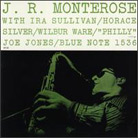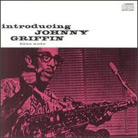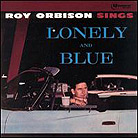![[SoundStage!]](../sslogo3.gif) The Vinyl Word The Vinyl WordBack Issue Article |
July 2003 Found on Vinyl: J.R. Monterose, Johnny Griffin, and Roy Orbison Life is full of little ironies, isn’t it? Take the world of recorded music, for instance. First, the 33 1/3 long-playing record (which had already beaten out the 45 in the record-speed derby) displaces 78s in the hearts and pocketbooks of consumers. Then, stereo arrives to replace mono as the LP’s recording format of choice. Next up, the compact disc is introduced and quickly replaces the LP as the storage and playback medium of mass acceptance. Now, today, we have two new high-resolution digital playback formats, SACD and DVD-A, vying to replace the CD. So isn't it more than a little ironic that mono LPs are not only still being pressed, but that audiophiles the world over are paying premium prices to acquire them? Not when you listen to them it’s not -- and Michael Hobson of Classic Records would surely agree. With so much of our musical heritage, especially jazz and early pop, recorded only in mono, Hobson realized that there was a vast treasure trove of music that had seemingly been overlooked. Without intervention, this music could very well pass from the realm of general availability. So he’s done something about it. Thus, it was with eager anticipation that I acquired three of the latest mono releases from Classic Records on their new Quiet SV-P 200-gram vinyl: J.R. Monterose, Introducing Johnny Griffin ([BN-1563] and [BN-1533], both Blue Note jazz reissues), and Roy Orbison’s Lonely And Blue ([M4002] originally on Monument Records).
As I’ve come to expect from any recording that Lion and engineer Rudy Van Gelder created, the music was a wonderfully recorded example of hard-bop jazz. There is much of the sound of Sonny Rollins in the tenor of J.R. Monterose, and that is both the high point of this record and possible cause for Monterose’s failure to catch the public’s attention. Why listen to someone who sounds like Rollins when you can hear the real thing on the same label? It’s too bad, as Monterose brought his own perspective to this album. Where Rollins tended toward the constantly inventive, Monterose waxed more lyrical. Over and above Monterose’s playing, both Sullivan, whose work here should have gotten him his own Blue Note contract, and Jones, who plays in a much more subdued manner than was usual for him, almost steal the show.
That Griffin studied at the "University of Bird" is without question. That he’s no mere copycat is equally obvious. As he demonstrates here, there is little he finds difficult to play, and play well. Styles ranging from the fast and furious ("Mil Dew") to medium swing ("Nice and Easy") to slow ballads ("These Foolish Things") are handled with equal aplomb. One listen to his supporting cast and it becomes easy to see the reason Kelly was so highly thought of by Miles Davis, and why Max Roach has appeared on so many great jazz albums: These cats have great ears and can play anything. Introducing Johnny Griffin became something of a launching pad for Griffin’s career -- a career that continues unabated today. And now, to quote Monty Python, for something completely different -- the lush, creamy, powerful pop vocal talents of Roy Orbison. When I noticed that Lonely and Blue was among Classic’s list of recent releases, I knew I had to have it. It’s impossible to have too much Roy Orbison.
What makes these three albums even more enticing is Classic’s new Quiex SV-P 200-gram vinyl. Now, I already own quite a few of Classic’s previous 180-gram reissues, ranging from jazz to rock to classical, and each is superb in its own way. But the new vinyl formula takes already vanishingly low vinyl noise levels to an even lower, digital-like silence. I'm talking low enough for even the most jaded of audiophiles. If the major record companies had taken the time and effort to press records of the quality of these Classic titles, we’d all still be spinning vinyl today and not lost in the throes of yet another format battle. These Classic titles are also dead flat (contrary to beliefs expressed on certain audiophile forums, all of my Classic titles have exhibited nary a trace of warp) and extremely clean; there wasn’t a tick or pop to be heard. They allowed me to listen further into the music than any LPs I’ve heard from Classic previously. Both of the jazz titles, recorded way back in 1956, contain musical details I’m not sure even Rudy Van Gelder knew was on the tape (all right, so maybe I’m exaggerating just a tad, but only just). And so what if they’re only mono -- that’s the manner in which they were recorded and you won't care after the initial bars. Both Griffin's and Monterose’s saxophones are front and center and very clearly rendered. The rhythm sections are set back slightly but with plenty of detail evident. The bass is deep, full, and very present; the drums crackle; and the cymbals shimmer (especially on the Monterose LP). Only the piano isn’t quite up to snuff, sounding a bit hooded (but that’s a problem with Van Gelder’s recording technique, not the LPs). With Classic’s new Quiex SV-P vinyl formulas lowering the noise floor to digitally low levels, any of these pressings will draw you further into the music. Should you wind up purchasing any of these albums, be prepared for new and exciting vinyl pleasures. How ironic, in these days of true high-rez digital, that this may be the best of times to be a vinylphile. ...John Crossett
|
|
![[SoundStage!]](../sslogo3.gif) All Contents All ContentsCopyright © 2003 SoundStage! All Rights Reserved |
 J.R. Monterose
is one of the rarer of the Blue Note titles reissued by Classic, due no doubt to it being
both tenor-saxophonist Frank Anthony Monterose Jr.’s debut as well as his swan song
for the label. That alone piqued my interest in the music. Another thing that makes this
album interesting is the supporting cast Monterose was given by Blue Note head Alfred
Lion. Trumpeter Ira Sullivan (one of jazz’s unjustly neglected musicians), pianist
Horace Silver, bassist Wilber Ware, and drummer "Philly" Joe Jones provided
Monterose superb support.
J.R. Monterose
is one of the rarer of the Blue Note titles reissued by Classic, due no doubt to it being
both tenor-saxophonist Frank Anthony Monterose Jr.’s debut as well as his swan song
for the label. That alone piqued my interest in the music. Another thing that makes this
album interesting is the supporting cast Monterose was given by Blue Note head Alfred
Lion. Trumpeter Ira Sullivan (one of jazz’s unjustly neglected musicians), pianist
Horace Silver, bassist Wilber Ware, and drummer "Philly" Joe Jones provided
Monterose superb support. Introducing
Johnny Griffin was, like the Monterose album, the tenor’s debut with Blue Note.
But where Monterose soon slipped off the radar screen, Griffin went on to become one of
the preeminent modern tenor saxophonists. Billed as "The Fastest Tenor in the
World" (just listen to him play on "It’s Alright With Me"), Griffin,
supported by Wynton Kelly on piano, Curly Russell on bass, and jazz legend Max Roach on
drums, earned that title with his work here. Right from the opening tune, "Mil
Dew," he’s flying. By the time of this recording, Griffin had gained
experience playing with the likes of Lionel Hampton, Dizzy Gillespie, and Thelonious Monk
(with whom he’d go onto record two terrific albums, Misterio and In Action).
Introducing
Johnny Griffin was, like the Monterose album, the tenor’s debut with Blue Note.
But where Monterose soon slipped off the radar screen, Griffin went on to become one of
the preeminent modern tenor saxophonists. Billed as "The Fastest Tenor in the
World" (just listen to him play on "It’s Alright With Me"), Griffin,
supported by Wynton Kelly on piano, Curly Russell on bass, and jazz legend Max Roach on
drums, earned that title with his work here. Right from the opening tune, "Mil
Dew," he’s flying. By the time of this recording, Griffin had gained
experience playing with the likes of Lionel Hampton, Dizzy Gillespie, and Thelonious Monk
(with whom he’d go onto record two terrific albums, Misterio and In Action). Lonely and
Blue was Orbison’s LP recording debut, catapulting him to both superstardom and
pop-music-icon status. Containing the hits "Only the Lonely" and "Blue
Angel," this album had everything Orbison fans would come to expect from their hero.
Here we have Orbison-penned originals (the two hit songs along with "Blue
Avenue," "Come Back to Me," "I’m Hurtin’," and
"I’ll Say it’s My Fault"), cover tunes ("Bye, Bye Love,"
"I Can’t Stop Loving You," and "Twenty One Days"), and songs
chosen to allow Orbison to demonstrate his vocal prowess ("Cry,"
"Raindrops," and "Legend in My Time"). Every vocal and musical nuance
that legendary RCA recording engineer Bill Porter caught on tape is on display on this LP
-- awaiting only your stylus to release them in all their glory. There is no hyperbole in
saying that this is a must-own album for any serious music lover.
Lonely and
Blue was Orbison’s LP recording debut, catapulting him to both superstardom and
pop-music-icon status. Containing the hits "Only the Lonely" and "Blue
Angel," this album had everything Orbison fans would come to expect from their hero.
Here we have Orbison-penned originals (the two hit songs along with "Blue
Avenue," "Come Back to Me," "I’m Hurtin’," and
"I’ll Say it’s My Fault"), cover tunes ("Bye, Bye Love,"
"I Can’t Stop Loving You," and "Twenty One Days"), and songs
chosen to allow Orbison to demonstrate his vocal prowess ("Cry,"
"Raindrops," and "Legend in My Time"). Every vocal and musical nuance
that legendary RCA recording engineer Bill Porter caught on tape is on display on this LP
-- awaiting only your stylus to release them in all their glory. There is no hyperbole in
saying that this is a must-own album for any serious music lover.